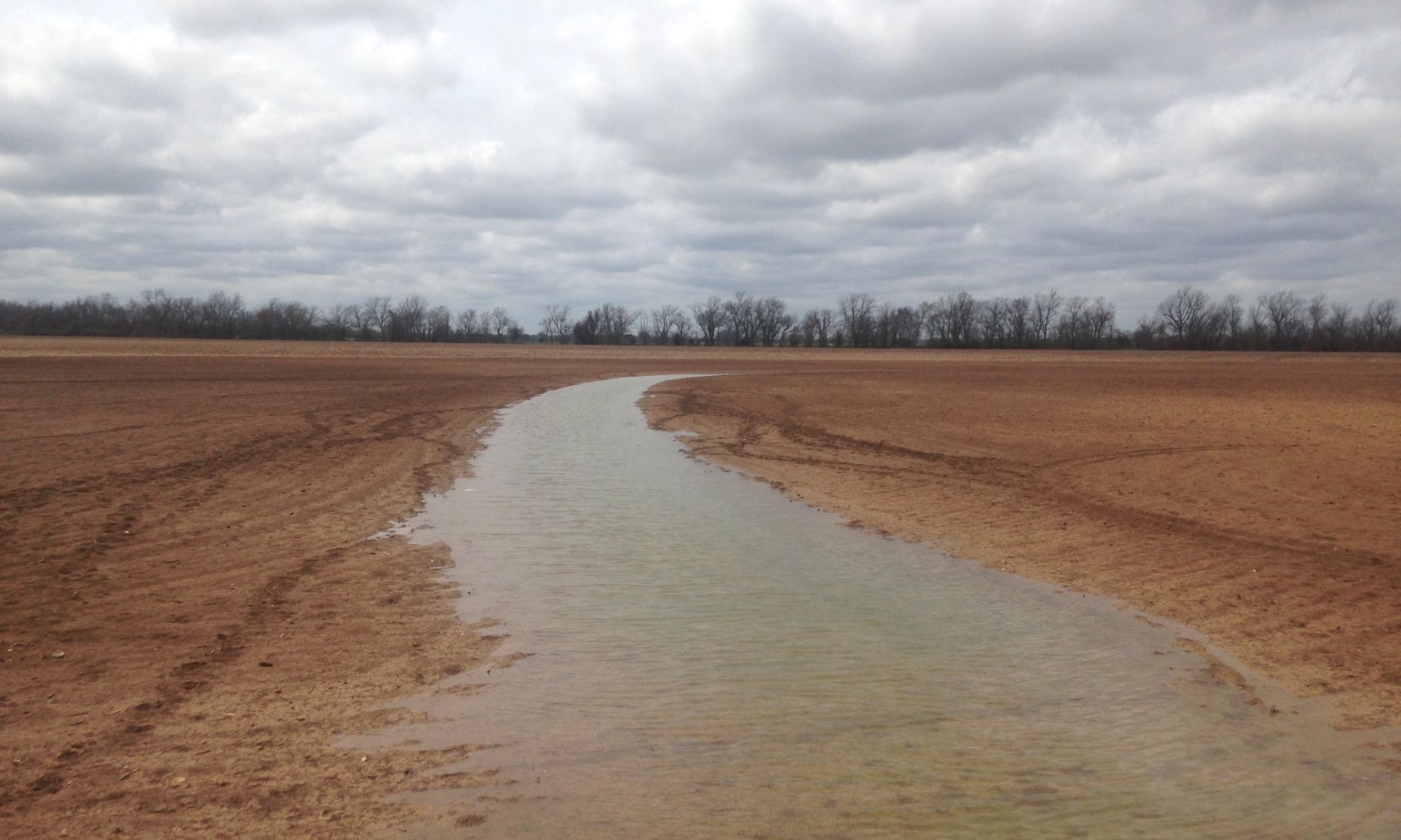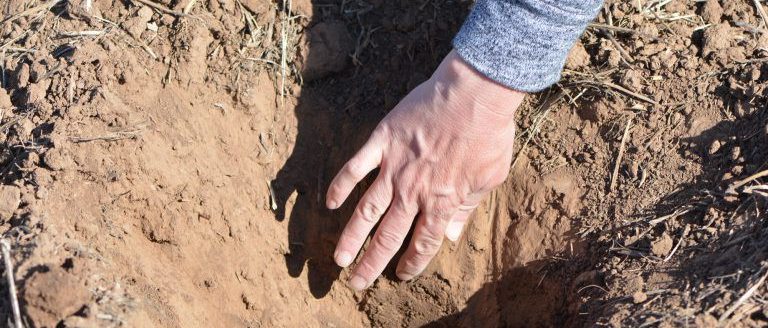Recent rainfall has set up much of the state for spring crop planting, but other areas continue to experience drought, said a Texas A&M AgriLife Extension Service expert.
Cotton planting in irrigated fields began more than a week ago in the Rio Grande Valley, said Gaylon Morgan, AgriLife Extension cotton specialist, College Station, but has been slow due to intermittent cool temperatures this year. Dryland fields will need rain before growers commit to planting their cotton crop.
“Planting in 2018 seems later, but that’s just because growers started planting earlier than usual last year due to the warm temperatures,” he said. “Some cotton is up already, but growers without irrigation are waiting for rain.”
Drought conditions continue for other areas of the state, especially West Texas and the upper High Plains and Panhandle, Morgan said.
“Most of the west Texas region didn’t receive any substantial rain and continues to endure extreme drought conditions according to the U.S. drought monitor,” he said. “Luckily, we have until June for rain in those areas to accumulate precipitation, but the lack of moisture is worrying many growers.”
Morgan said rainfall and some snow fell in a majority of the southern and central Rolling Plains and these rainfall events provided some reprieve from a very dry fall and winter for the Blacklands of Texas. Unfortunately, much of the northern Rolling Plains missed this rainfall.
The moisture should help planting conditions as producers statewide prepare to plant more cotton acres than the previous year, he said. Cotton acres were expected to increase almost 4 percent statewide to 7.15 million acres in 2018, according to a National Cotton Council survey.
Some areas are expected to see big jumps in cotton acres, including the Northern Blacklands where a 40 percent increase from 93,000 acres to over 140,000 acres was expected. Other regions will increase acres 8 to 15 percent, including the Southern Blacklands, Coastal regions and the Rio Grande Valley, according to survey data.
“Increased interest in cotton among producers reflects the market prices of both cotton and grain prices that are not so good,” he said. “When producers are choosing between making money and losing the least amount possible, they’re going with the best option with current market prices.”
AgriLife Extension district reporters compiled the following summaries:
Central: Large amounts of heavy rainfall was received. Freezing rain and ice storms caused severe damage. Most dryland small grain crops were in poor condition to dead, but producers hoped rainfall would bring viable fields back. Ryegrass planted for grazing was severely damaged from freezing conditions. Fields were expected to be prepared soon for spring planting. Spring calving season was underway. Livestock were being supplemented with hay and protein. Stock tank levels were low. All counties reported good soil moisture. Overall crop, rangeland and pasture conditions were mostly good.
Rolling plains: The winter months were dry until the reporting period. Moisture came in the form of rain, sleet and freezing rain with totals reported from 0.3 to 5 inches. Counties that received more frozen moisture experienced tree damage and power losses. Before the moisture, wheat and pasture conditions were poor to fair. Moisture was still needed to salvage the wheat crop and to fill stock tanks. Pastures and rangeland had an abundant amount of dry or dead forage, which increased wildfire potential to levels that burn bans were issued in some counties. Cattle were being fed supplements on a daily basis and producers looked at downsizing herds due to lack of forage. Calf prices remained high, and ranchers were weaning calves early and sending them to market. Cotton harvest was complete in most areas, however, gins were running full-time trying to get the 2017 crop out of the fields and ginned in a timely manner.
Coastal bend: Many areas received good rainfall. Mild temperatures and adequate moisture levels were reported. The ground temperature was still cold, which caused many to hold off planting. Corn seed was planted and should finish soon if weather conditions allow. A little grain sorghum was planted, but most were waiting for drier conditions. Some aerial spraying occurred to control weeds. Green grass was starting to emerge and pastures looked much better. Colder winter conditions had ranchers feeding lots of hay from ample supplies. Cattle remained in fair condition and overall conditions were good.
East: Wet conditions were reported from all counties around the district. Henderson County received 5 to 8 inches of rain. Wood County received 7 to 9 inches of rain. Heavy rains caused pastures to flood and hold water. In Anderson County, 15 percent of wheat fields were under water and the other 85 percent were soggy. Vegetable croplands were too wet to work or plant. Jasper County’s crop planting and winter herbicide applications were delayed. Pastures were saturated in Cherokee, Gregg, San Augustine and Shelby counties. Henderson County had high demand for round hay bales and low supplies. Harrison County reported dirt roads were impassable. Four-wheel drive vehicles were getting stuck on top of hills. Winter pastures not under water were doing well with current temperatures in Houston County. Ryegrass was growing well in Cherokee and Wood counties. Warm-season forages were starting to emerge in Cherokee County. Cattle were bogging down in pastures in Trinity County and were pulled from saturated pastures around the district. Smith County reported livestock were in fair to good condition with supplementation taking place. Houston County reported the cattle market was down in terms of headcount. Houston, Anderson and Gregg counties all reported higher market prices on cattle. In Henderson and Upshur counties, wild pigs were causing a lot of damage.
South plains: Parts of the district received up to 0.3 of an inch of rain, while other counties remained extremely dry. Fire dangers were present in all counties due to the lack of moisture. Winter wheat growth was very minimal. Pastures and winter wheat were suffering significantly.
Panhandle: Temperatures ranged from the high 70s to the low 20s. Soil moisture was mostly very short. A good general rain was needed throughout the region. High winds and no moisture created high fire danger. The district continued to experience drought. Lack of moisture put a severe strain on cattle in wheat pastures. Stocker cattle were being removed from the wheat and moved to feed yards and other areas with sufficient rainfall to support forage production. Dallam and Hartley counties experienced a few snow flurries but no accumulations. Some producers were stockpiling manure to fertilize corn fields. Field activities should pick up in the coming weeks. Supplemental feeding of cow-calf pairs was very active in recent weeks as forage was in short supply. Some producers moved cows to pastures to begin spring calving in the coming weeks. Lice on cattle were worse than normal this winter and wide swings in temperatures and dusty conditions continued to create health issues for stocker calves.
North: Heavy rains fell in all counties, with amounts ranging from 4 to 12 inches. Small grains and winter pastures were waterlogged and farming activities were at a standstill. Some farmers were lucky enough to fertilize before the rain, and with a few days of sunshine, it made a huge difference over the past week. Ryegrass and clover were behind but growing. Cattle were doing well but the week of rain and cold weather was not easy on them. Livestock were being monitored for stress due to the tremendous amount of rain. A few days of sunshine and a little growth in the pasture allowed some grazing. The livestock market was slow due to rain. Hay feeding continued. Wild pig activities increased since the rain softened the ground.
Far west: Weather was dry, but temperatures varied from highs in the 30s to 70s. Winds caused concern for fires. Wildlife grazing and a lack of rainfall for the past couple of months left most of the district with almost nothing green. Significant moisture will be needed in the next couple of months to plant cotton and was needed for corn, sorghum, wheat and pastures. Producers continued to prepare fields for this year’s crop. Lambing and kidding started across the district.
West central: Temperatures were very seasonable. A cold front brought much needed rainfall to most areas. Winter months were extremely dry. No measurable moisture was reported for the last four months until the last reporting period. Fields were worked and prepared for spring planting. Wheat fields and rangelands were suffering from moisture stress and continued to look poor. Soil moisture continued to decline. Cool-season forages were dormant due to dry conditions. Recent rains may help wheat and pasture conditions soon. Pastures were short on grazing and hay was in high demand. Livestock remained in mostly fair condition. Livestock were being sold due to extreme dry conditions. Supplemental feeding remained very heavy. Producers were feeding hay longer than anticipated. Stock tank water levels were very low but recent rains helped to improve conditions.
Southeast: Brazoria County received heavy rains, which made it difficult to plant corn. Many producers were behind in planting. In Walker County, moisture helped cool-season forages. Cooler temperatures slowed growth, but approaching warmer weather should allow production to increase significantly. In Brazos County, wet field conditions prevented producers from planting corn. Warmer temperatures were finally allowing cool-season forages to grow. In Montgomery County, pastures were completely saturated. Rains continued and weather had not allowed fields to dry. In Jefferson County, conditions were extremely wet. Cattle were stressed coming out of winter. Some areas in Lee County received 5 inches of rain. Sunshine and dry weather was needed. Rangeland and pasture ratings varied widely from excellent to very poor with fair ratings being most common.
Southwest: Recent rains in most counties improved soil moisture levels, helped rangeland and pasture conditions. Green grass was beginning to emerge. Livestock conditions remained fair to good.
South: Northern portions of the district reported dry weather with fair rangeland and pasture conditions. Soil moisture levels remained low and rain events over the past three months were below average. Conditions in some counties improved after rainfall and weather was starting to warm up. Frio County reported cold temperatures and much needed rainfall at the end of the reporting period. Potato preparations were completed and wheat and oats were under irrigation before rains. Supplemental feeding was steady and body condition scores on cattle declined with most herds in fair condition. Western portions of the district reported mild weather, some drizzle and fair rangeland and pasture conditions. Coastal Bermuda grass fields were not producing and other crop fields were being prepared for planting. Zavala County received steady heavy drizzle during most of the reporting period that should provide slight relief for dry soil conditions and benefit dryland wheat and oats. Spinach harvest was active. Livestock producers reported some light to moderate supplemental feeding. In Dimmit County, conditions were favorable for forage production following rainfall. Zapata County reported no rain and several hard freeze weather events, which caused poor rangeland conditions. Supplemental feeding with hay and cubes continued. Eastern portions of the district reported rainfall with poor to fair rangeland and pasture conditions. Soil moisture conditions in Jim Wells County improved over the last month with some amounts of rain received. Planting season was off to a good start. Rangeland and pasture conditions were not providing significant forage production. Winter weeds emerged and were providing some grazing for cattle. Duval County received plenty of moisture and winter crops, including wheat and oats, were doing well. Temperatures changed from hot to cold daily. Ranchers were providing supplements to cattle and wildlife. Kleberg and Kennedy counties reported poor rangeland conditions. Conditions were mild in the southernmost parts of the district with fair pasture and rangeland conditions. Some rainfall was received in Starr County. Row-crop planting began for dryland farmers. In Hidalgo County, corn, grain sorghum and cotton plantings were very active. Harvesting of sugarcane, citrus and vegetables continued while sunflower planting was complete.



